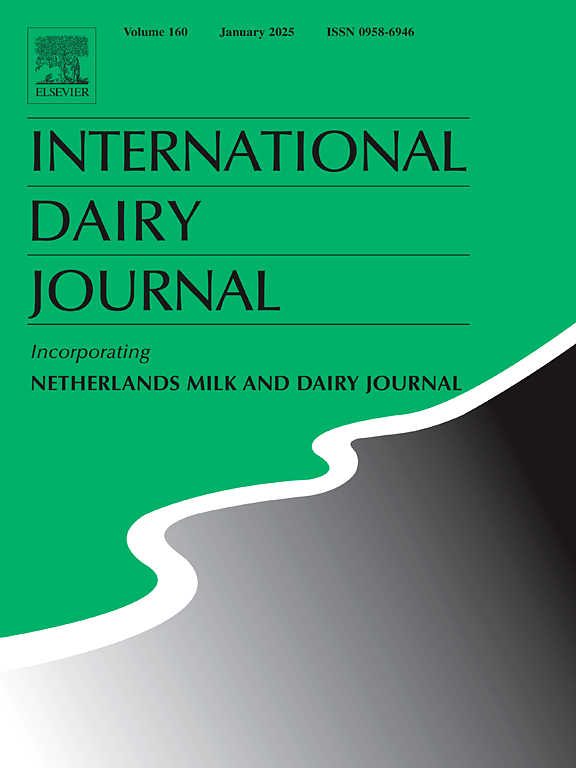电解水对白软干酪微生物控制的研究
IF 3.1
3区 农林科学
Q2 FOOD SCIENCE & TECHNOLOGY
引用次数: 0
摘要
白软奶酪是埃及消费最广泛的奶酪品种之一,由于其高水分,通常具有较高的被污染风险。因此,当前研究的目的是评估白软奶酪的微生物质量,特别是Thalaga奶酪和生的和巴氏消毒的Kareish奶酪。此外,还验证了碱性电解水和酸性电解水的组合对降低高污染样品中的微生物负荷的效果。从埃及开罗的各种商店、街头小贩和超市中随机收集了90个样本(每个30个)。分析样品中大肠菌群、大肠杆菌、金黄色葡萄球菌、霉菌和酵母菌的总数。Kareish原料样品微生物污染发生率较高,总大肠菌群、大肠杆菌、金黄色葡萄球菌、霉菌和酵母的检出率分别为90.0、90.0、76.6、93.3和100%。同样,Thalaga奶酪的污染率分别为60.0、56.6、50.0、60.0和100%,而巴氏灭菌的Kareish奶酪的污染率明显较低(36.6%、23.3、0、33.3和86.6%)。有趣的是,先用AIEW再用AcEW处理后,Kareish样品中总大肠菌群、大肠杆菌、金黄色葡萄球菌、霉菌和酵母的微生物数量分别减少了1.77、3.42、2.60、1.38和0.97 log CFU/g,而Thalaga样品的微生物数量减少了1.69、2.82、2.06、0.89和0.60 log CFU/g。人们注意到,经过电解水处理的生Kareish和Thalaga奶酪完全消除了大肠杆菌和金黄色葡萄球菌,达到了埃及标准。总之,这些发现突出表明,在埃及开罗,需要在奶酪加工过程中采取严格的卫生措施,以确保乳制品的安全。此外,这两种类型的电解水的组合有可能提高白软奶酪的微生物质量和安全性。本文章由计算机程序翻译,如有差异,请以英文原文为准。
Electrolyzed water as a microbial control measure for white soft cheese
White soft cheese is among the most widely consumed varieties of cheese in Egypt, and it is usually at a higher risk of being contaminated due to its high moisture. So, the purpose of the current study was to assess the microbiological quality of white soft cheese, specifically Thalaga cheese and raw and pasteurized Kareish cheese. Moreover, demonstrate the efficacy of the combination of alkaline Electrolyzed water followed by acidic Electrolyzed water to reduce the microbial load in the highly contaminated samples. Ninety random samples (30 each) were collected from various stores, street vendors, and supermarkets across Cairo, Egypt. Samples were analyzed for the total coliforms, Escherichia coli, Staphylococcus aureus, molds, and yeast counts. There was a high incidence of microbial contamination in raw Kareish samples, with detection rates of 90.0, 90.0, 76.6, 93.3, and 100% for total coliforms, E. coli, S. aureus, molds, and yeasts, respectively. Similarly, contamination rates were 60.0, 56.6, 50.0, 60.0, and 100% in Thalaga, whereas pasteurized Kareish cheese recorded significantly lower contamination rates (36.6, 23.3, 0, 33.3, and 86.6%). Interestingly, microbial counts after treating samples firstly with AIEW then AcEW for total coliforms, E. coli, S. aureus, molds, and yeasts decreased by 1.77, 3.42, 2.60, 1.38, and 0.97 log CFU/g, respectively in raw Kareish, whereas for Thalaga, the microbial reduction was 1.69, 2.82, 2.06, 0.89, and 0.60 log CFU/g. It was noticed that there was a complete elimination of E.coli and S.aureus to meet the Egyptian standards for both raw Kareish and Thalaga cheeses after treatment with electrolyzed water. In conclusion, these findings highlighted the need for strict hygienic practices during cheese processing to ensure the safety of dairy products in Cairo, Egypt. Additionally, this combining of two types of electrolyzed water has potential for improving the microbiological quality and safety of white soft cheese.
求助全文
通过发布文献求助,成功后即可免费获取论文全文。
去求助
来源期刊

International Dairy Journal
工程技术-食品科技
CiteScore
6.50
自引率
9.70%
发文量
200
审稿时长
49 days
期刊介绍:
The International Dairy Journal publishes significant advancements in dairy science and technology in the form of research articles and critical reviews that are of relevance to the broader international dairy community. Within this scope, research on the science and technology of milk and dairy products and the nutritional and health aspects of dairy foods are included; the journal pays particular attention to applied research and its interface with the dairy industry.
The journal''s coverage includes the following, where directly applicable to dairy science and technology:
• Chemistry and physico-chemical properties of milk constituents
• Microbiology, food safety, enzymology, biotechnology
• Processing and engineering
• Emulsion science, food structure, and texture
• Raw material quality and effect on relevant products
• Flavour and off-flavour development
• Technological functionality and applications of dairy ingredients
• Sensory and consumer sciences
• Nutrition and substantiation of human health implications of milk components or dairy products
International Dairy Journal does not publish papers related to milk production, animal health and other aspects of on-farm milk production unless there is a clear relationship to dairy technology, human health or final product quality.
 求助内容:
求助内容: 应助结果提醒方式:
应助结果提醒方式:


